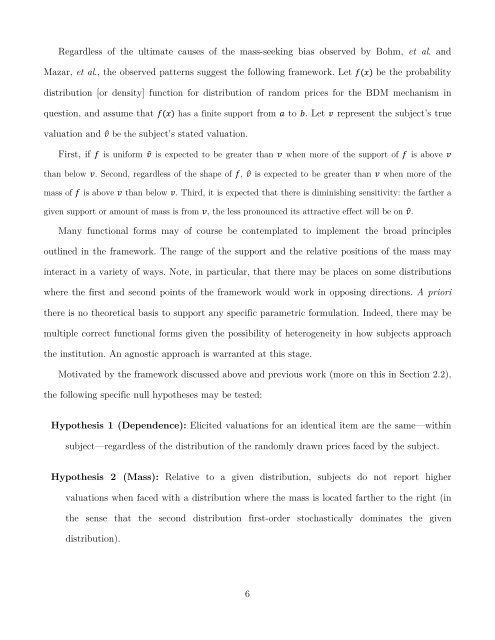Testing Distributional Dependence in the Becker-DeGroot-Marschak ...
Testing Distributional Dependence in the Becker-DeGroot-Marschak ...
Testing Distributional Dependence in the Becker-DeGroot-Marschak ...
You also want an ePaper? Increase the reach of your titles
YUMPU automatically turns print PDFs into web optimized ePapers that Google loves.
Regardless of <strong>the</strong> ultimate causes of <strong>the</strong> mass-seek<strong>in</strong>g bias observed by Bohm, et al. and<br />
Mazar, et al., <strong>the</strong> observed patterns suggest <strong>the</strong> follow<strong>in</strong>g framework. Let �(�) be <strong>the</strong> probability<br />
distribution [or density] function for distribution of random prices for <strong>the</strong> BDM mechanism <strong>in</strong><br />
question, and assume that �(�) has a f<strong>in</strong>ite support from � to �. Let � represent <strong>the</strong> subject’s true<br />
valuation and �� be <strong>the</strong> subject's stated valuation.<br />
First, if � is uniform �� is expected to be greater than � when more of <strong>the</strong> support of � is above �<br />
than below �. Second, regardless of <strong>the</strong> shape of �, �� is expected to be greater than � when more of <strong>the</strong><br />
mass of � is above � than below �. Third, it is expected that <strong>the</strong>re is dim<strong>in</strong>ish<strong>in</strong>g sensitivity: <strong>the</strong> far<strong>the</strong>r a<br />
given support or amount of mass is from �, <strong>the</strong> less pronounced its attractive effect will be on ��.<br />
Many functional forms may of course be contemplated to implement <strong>the</strong> broad pr<strong>in</strong>ciples<br />
outl<strong>in</strong>ed <strong>in</strong> <strong>the</strong> framework. The range of <strong>the</strong> support and <strong>the</strong> relative positions of <strong>the</strong> mass may<br />
<strong>in</strong>teract <strong>in</strong> a variety of ways. Note, <strong>in</strong> particular, that <strong>the</strong>re may be places on some distributions<br />
where <strong>the</strong> first and second po<strong>in</strong>ts of <strong>the</strong> framework would work <strong>in</strong> oppos<strong>in</strong>g directions. A priori<br />
<strong>the</strong>re is no <strong>the</strong>oretical basis to support any specific parametric formulation. Indeed, <strong>the</strong>re may be<br />
multiple correct functional forms given <strong>the</strong> possibility of heterogeneity <strong>in</strong> how subjects approach<br />
<strong>the</strong> <strong>in</strong>stitution. An agnostic approach is warranted at this stage.<br />
Motivated by <strong>the</strong> framework discussed above and previous work (more on this <strong>in</strong> Section 2.2),<br />
<strong>the</strong> follow<strong>in</strong>g specific null hypo<strong>the</strong>ses may be tested:<br />
Hypo<strong>the</strong>sis 1 (<strong>Dependence</strong>): Elicited valuations for an identical item are <strong>the</strong> same—with<strong>in</strong><br />
subject—regardless of <strong>the</strong> distribution of <strong>the</strong> randomly drawn prices faced by <strong>the</strong> subject.<br />
Hypo<strong>the</strong>sis 2 (Mass): Relative to a given distribution, subjects do not report higher<br />
valuations when faced with a distribution where <strong>the</strong> mass is located far<strong>the</strong>r to <strong>the</strong> right (<strong>in</strong><br />
<strong>the</strong> sense that <strong>the</strong> second distribution first-order stochastically dom<strong>in</strong>ates <strong>the</strong> given<br />
distribution).<br />
6


